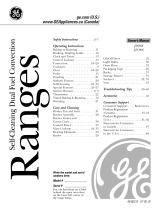3
Operating Instructions
Safety Instructions
Consumer Support
Troubleshooting Tips
ge.com
WARNING!
For your safety, the information in this manual must be followed to minimize the risk of fire or explosion,
electric shock, or to prevent property damage, personal injury, or loss of life.
Have the installer show you the location of the oven gas shut-off valve and how to shut it off if necessary.
■ Have your oven installed and properly
grounded by a qualified installer, in
accordance with the Installation
Instructions. Any adjustment and service
should be performed only by qualified gas
oven installers or service technicians.
■ Do not attempt to repair or replace any
part of your oven unless it is specifically
recommended in this manual. All other
service should be referred to a qualified
technician.
■ Be sure all packaging materials are
removed from the oven before operating
it to prevent fire or smoke damage should
the packaging material ignite.
■ Do not touch the interior surface of the
oven. These surfaces may be hot enough
to burn even though they are dark in
color. During and after use, do not touch,
or let clothing or other flammable
materials contact any interior area of the
oven; allow sufficient time for cooling first.
Potentially hot surfaces include the oven
vent openings, surfaces near the opening
and crevices around the door.
Remember:
The inside surfaces of an oven
may be hot when the door is opened.
■ Be sure your oven is correctly adjusted by
a qualified service technician or installer
for the type of gas (natural or LP) that is
to be used. Your oven can be converted
for use with either type of gas. See the
Installation Instructions.
■
WARNING:
These adjustments
must be made by a qualified service
technician in accordance with the
manufacturer’s instructions and all
codes and requirements of the authority
having jurisdiction. Failure to follow these
instructions could result in serious injury
or property damage. The qualified agency
performing this work assumes
responsibility for the conversion.
■ Be sure the oven is securely installed
in a cabinet that is firmly attached to the
house structure. Never allow anyone to
climb, sit, stand or hang on the oven door.
■ Do not leave children alone or unattended
where an oven is hot or in operation. They
could be seriously burned.
■ Do not allow anyone to climb, stand or
hang on the oven door or broiler drawer.
They could damage the oven.
SAFETY PRECAUTIONS
IMPORTANT SAFETY NOTICE
The California Safe Drinking Water and Toxic Enforcement Act requires the Governor of California to
publish a list of substances known to the state to cause birth defects or other reproductive harm, and
requires businesses to warn customers of potential exposure to such substances.
Gas appliances can cause minor exposure to four of these substances, namely benzene, carbon
monoxide, formaldehyde and soot, caused primarily by the incomplete combustion of natural gas or
LP fuels. Properly adjusted burners, indicated by a bluish rather than a yellow flame, will minimize
incomplete combustion. Exposure to these substances can be minimized by venting with an open
window or using a ventilation fan or hood.
IMPORTANT: The health of some birds is extremely sensitive to the fumes given off during
the self-cleaning cycle of any oven. Move birds to another well-ventilated room.




















